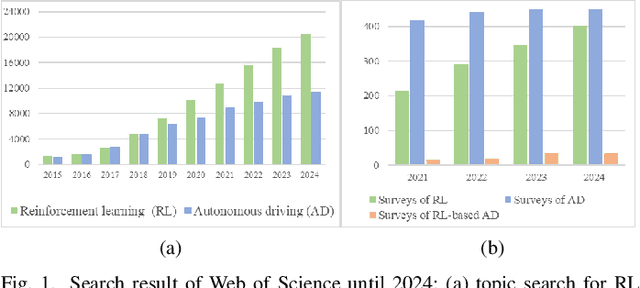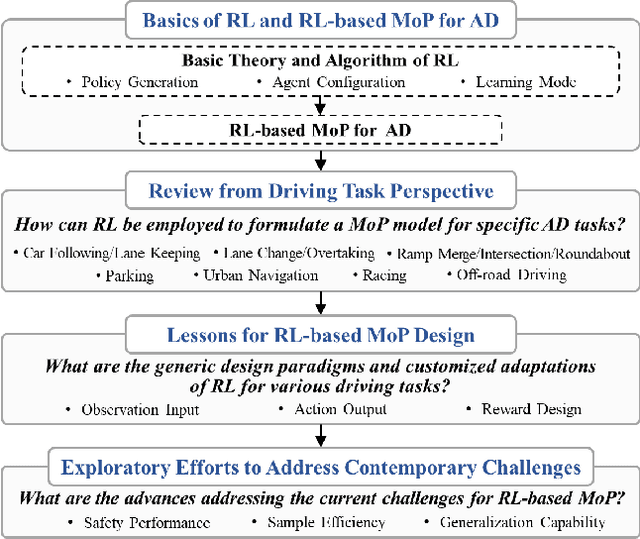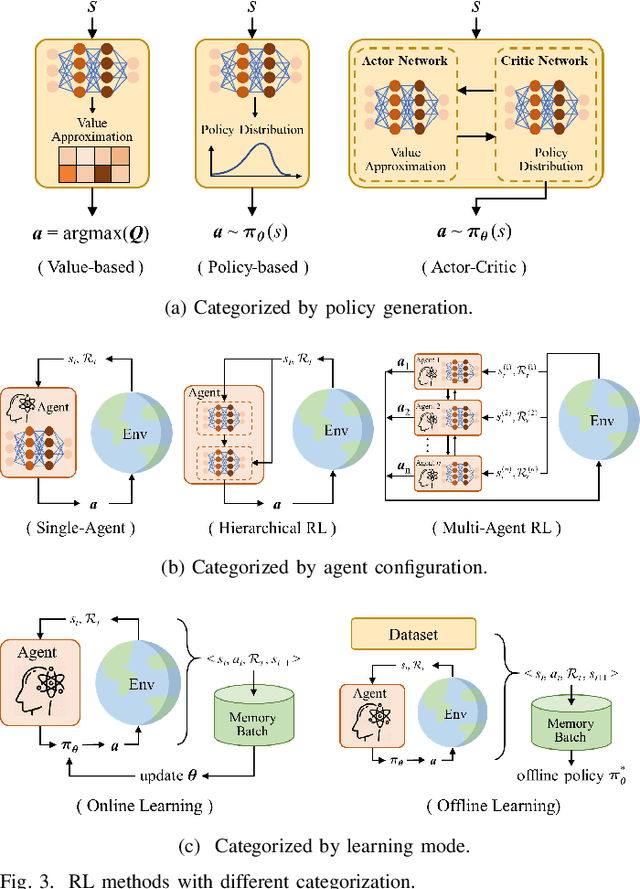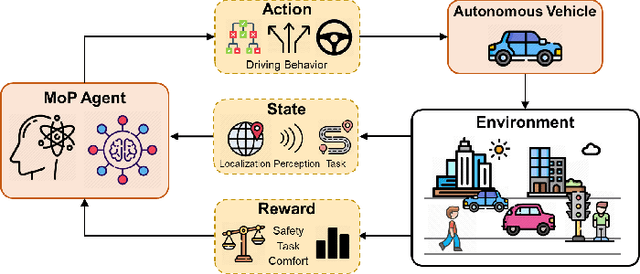Jia Hu
Jason
Risk Map As Middleware: Towards Interpretable Cooperative End-to-end Autonomous Driving for Risk-Aware Planning
Aug 11, 2025Abstract:End-to-end paradigm has emerged as a promising approach to autonomous driving. However, existing single-agent end-to-end pipelines are often constrained by occlusion and limited perception range, resulting in hazardous driving. Furthermore, their black-box nature prevents the interpretability of the driving behavior, leading to an untrustworthiness system. To address these limitations, we introduce Risk Map as Middleware (RiskMM) and propose an interpretable cooperative end-to-end driving framework. The risk map learns directly from the driving data and provides an interpretable spatiotemporal representation of the scenario from the upstream perception and the interactions between the ego vehicle and the surrounding environment for downstream planning. RiskMM first constructs a multi-agent spatiotemporal representation with unified Transformer-based architecture, then derives risk-aware representations by modeling interactions among surrounding environments with attention. These representations are subsequently fed into a learning-based Model Predictive Control (MPC) module. The MPC planner inherently accommodates physical constraints and different vehicle types and can provide interpretation by aligning learned parameters with explicit MPC elements. Evaluations conducted on the real-world V2XPnP-Seq dataset confirm that RiskMM achieves superior and robust performance in risk-aware trajectory planning, significantly enhancing the interpretability of the cooperative end-to-end driving framework. The codebase will be released to facilitate future research in this field.
Toward a Full-Stack Co-Simulation Platform for Testing of Automated Driving Systems
Jul 09, 2025Abstract:Virtual testing has emerged as an effective approach to accelerate the deployment of automated driving systems. Nevertheless, existing simulation toolchains encounter difficulties in integrating rapid, automated scenario generation with simulation environments supporting advanced automated driving capabilities. To address this limitation, a full-stack toolchain is presented, enabling automatic scenario generation from real-world datasets and efficient validation through a co-simulation platform based on CarMaker, ROS, and Apollo. The simulation results demonstrate the effectiveness of the proposed toolchain. A demonstration video showcasing the toolchain is available at the provided link: https://youtu.be/taJw_-CmSiY.
A Communication-Latency-Aware Co-Simulation Platform for Safety and Comfort Evaluation of Cloud-Controlled ICVs
Jun 09, 2025Abstract:Testing cloud-controlled intelligent connected vehicles (ICVs) requires simulation environments that faithfully emulate both vehicle behavior and realistic communication latencies. This paper proposes a latency-aware co-simulation platform integrating CarMaker and Vissim to evaluate safety and comfort under real-world vehicle-to-cloud (V2C) latency conditions. Two communication latency models, derived from empirical 5G measurements in China and Hungary, are incorporated and statistically modeled using Gamma distributions. A proactive conflict module (PCM) is proposed to dynamically control background vehicles and generate safety-critical scenarios. The platform is validated through experiments involving an exemplary system under test (SUT) across six testing conditions combining two PCM modes (enabled/disabled) and three latency conditions (none, China, Hungary). Safety and comfort are assessed using metrics including collision rate, distance headway, post-encroachment time, and the spectral characteristics of longitudinal acceleration. Results show that the PCM effectively increases driving environment criticality, while V2C latency primarily affects ride comfort. These findings confirm the platform's effectiveness in systematically evaluating cloud-controlled ICVs under diverse testing conditions.
Using Large Language Models to Tackle Fundamental Challenges in Graph Learning: A Comprehensive Survey
May 24, 2025Abstract:Graphs are a widely used paradigm for representing non-Euclidean data, with applications ranging from social network analysis to biomolecular prediction. Conventional graph learning approaches typically rely on fixed structural assumptions or fully observed data, limiting their effectiveness in more complex, noisy, or evolving settings. Consequently, real-world graph data often violates the assumptions of traditional graph learning methods, in particular, it leads to four fundamental challenges: (1) Incompleteness, real-world graphs have missing nodes, edges, or attributes; (2) Imbalance, the distribution of the labels of nodes or edges and their structures for real-world graphs are highly skewed; (3) Cross-domain Heterogeneity, graphs from different domains exhibit incompatible feature spaces or structural patterns; and (4) Dynamic Instability, graphs evolve over time in unpredictable ways. Recent advances in Large Language Models (LLMs) offer the potential to tackle these challenges by leveraging rich semantic reasoning and external knowledge. This survey provides a comprehensive review of how LLMs can be integrated with graph learning to address the aforementioned challenges. For each challenge, we review both traditional solutions and modern LLM-driven approaches, highlighting how LLMs contribute unique advantages. Finally, we discuss open research questions and promising future directions in this emerging interdisciplinary field. To support further exploration, we have curated a repository of recent advances on graph learning challenges: https://github.com/limengran98/Awesome-Literature-Graph-Learning-Challenges.
Efficient Federated Class-Incremental Learning of Pre-Trained Models via Task-agnostic Low-rank Residual Adaptation
May 18, 2025Abstract:Federated Parameter-Efficient Fine-Tuning (FedPEFT) reduces communication and computation costs in federated fine-tuning of pre-trained models by updating only a small subset of model parameters. However, existing approaches assume static data distributions, failing to adequately address real-world scenarios where new classes continually emerge, particularly in Federated Class Incremental Learning (FCIL). FCIL faces two key challenges: catastrophic forgetting and performance degradation caused by non-IID data across clients. Unlike current methods that maintain separate task-specific components or suffer from aggregation noise during parameter aggregation, we propose Federated Task-agnostic Low-rank Residual Adaptation (Fed-TaLoRA), a novel parameter-efficient approach for fine-tuning in resource-constrained FCIL scenarios. Specifically, we fine-tune only shared task-agnostic LoRA parameters across sequential tasks, effectively mitigating catastrophic forgetting while enabling efficient knowledge transfer among clients. Based on a theoretical analysis of aggregation, we develop a novel residual weight update mechanism that ensures accurate knowledge consolidation with minimal overhead. Our methodological innovations are attributed to three key strategies: task-agnostic adaptation, post-aggregation model calibration, and strategic placement of LoRA modules. Extensive experiments on multiple benchmark datasets demonstrate that Fed-TaLoRA consistently outperforms state-of-the-art methods in diverse data heterogeneity scenarios while substantially reducing resource requirements.
Memory-Efficient Orthogonal Fine-Tuning with Principal Subspace Adaptation
May 16, 2025Abstract:Driven by the relentless growth in model parameters, which renders full fine-tuning prohibitively expensive for large-scale deployment, parameter-efficient fine-tuning (PEFT) has emerged as a crucial approach for rapidly adapting large models to a wide range of downstream tasks. Among the PEFT family, orthogonal fine-tuning and its variants have demonstrated remarkable performance by preserving hyperspherical energy, which encodes pairwise angular similarity between neurons. However, these methods are inherently memory-inefficient due to the need to store intermediate activations from multiple full-dimensional sparse matrices. To address this limitation, we propose Memory-efficient Orthogonal Fine-Tuning (MOFT) with principal subspace adaptation. Specifically, we first establish a theoretical condition under which orthogonal transformations within a low-rank subspace preserve hyperspherical energy. Based on this insight, we constrain orthogonal fine-tuning to the principal subspace defined by the top-r components obtained through singular value decomposition and impose an additional constraint on the projection matrix to satisfy the preservation condition. To enhance MOFT's flexibility across tasks, we relax strict orthogonality by introducing two learnable scaling vectors. Extensive experiments on 37 diverse tasks and four models across NLP and CV demonstrate that MOFT consistently outperforms key baselines while significantly reducing the memory footprint of orthogonal fine-tuning.
Towards Robust Spiking Neural Networks:Mitigating Heterogeneous Training Vulnerability via Dominant Eigencomponent Projection
May 16, 2025Abstract:Spiking Neural Networks (SNNs) process information via discrete spikes, enabling them to operate at remarkably low energy levels. However, our experimental observations reveal a striking vulnerability when SNNs are trained using the mainstream method--direct encoding combined with backpropagation through time (BPTT): even a single backward pass on data drawn from a slightly different distribution can lead to catastrophic network collapse. Our theoretical analysis attributes this vulnerability to the repeated inputs inherent in direct encoding and the gradient accumulation characteristic of BPTT, which together produce an exceptional large Hessian spectral radius. To address this challenge, we develop a hyperparameter-free method called Dominant Eigencomponent Projection (DEP). By orthogonally projecting gradients to precisely remove their dominant components, DEP effectively reduces the Hessian spectral radius, thereby preventing SNNs from settling into sharp minima. Extensive experiments demonstrate that DEP not only mitigates the vulnerability of SNNs to heterogeneous data poisoning, but also significantly enhances overall robustness compared to key baselines, providing strong support for safer and more reliable SNN deployment.
A Robust Real-Time Lane Detection Method with Fog-Enhanced Feature Fusion for Foggy Conditions
Apr 08, 2025Abstract:Lane detection is a critical component of Advanced Driver Assistance Systems (ADAS). Existing lane detection algorithms generally perform well under favorable weather conditions. However, their performance degrades significantly in adverse conditions, such as fog, which increases the risk of traffic accidents. This challenge is compounded by the lack of specialized datasets and methods designed for foggy environments. To address this, we introduce the FoggyLane dataset, captured in real-world foggy scenarios, and synthesize two additional datasets, FoggyCULane and FoggyTusimple, from existing popular lane detection datasets. Furthermore, we propose a robust Fog-Enhanced Network for lane detection, incorporating a Global Feature Fusion Module (GFFM) to capture global relationships in foggy images, a Kernel Feature Fusion Module (KFFM) to model the structural and positional relationships of lane instances, and a Low-level Edge Enhanced Module (LEEM) to address missing edge details in foggy conditions. Comprehensive experiments demonstrate that our method achieves state-of-the-art performance, with F1-scores of 95.04 on FoggyLane, 79.85 on FoggyCULane, and 96.95 on FoggyTusimple. Additionally, with TensorRT acceleration, the method reaches a processing speed of 38.4 FPS on the NVIDIA Jetson AGX Orin, confirming its real-time capabilities and robustness in foggy environments.
A Survey of Reinforcement Learning-Based Motion Planning for Autonomous Driving: Lessons Learned from a Driving Task Perspective
Mar 31, 2025



Abstract:Reinforcement learning (RL), with its ability to explore and optimize policies in complex, dynamic decision-making tasks, has emerged as a promising approach to addressing motion planning (MoP) challenges in autonomous driving (AD). Despite rapid advancements in RL and AD, a systematic description and interpretation of the RL design process tailored to diverse driving tasks remains underdeveloped. This survey provides a comprehensive review of RL-based MoP for AD, focusing on lessons from task-specific perspectives. We first outline the fundamentals of RL methodologies, and then survey their applications in MoP, analyzing scenario-specific features and task requirements to shed light on their influence on RL design choices. Building on this analysis, we summarize key design experiences, extract insights from various driving task applications, and provide guidance for future implementations. Additionally, we examine the frontier challenges in RL-based MoP, review recent efforts to addresse these challenges, and propose strategies for overcoming unresolved issues.
Dynamic Pricing for On-Demand DNN Inference in the Edge-AI Market
Mar 06, 2025Abstract:The convergence of edge computing and AI gives rise to Edge-AI, which enables the deployment of real-time AI applications and services at the network edge. One of the fundamental research issues in Edge-AI is edge inference acceleration, which aims to realize low-latency high-accuracy DNN inference services by leveraging the fine-grained offloading of partitioned inference tasks from end devices to edge servers. However, existing research has yet to adopt a practical Edge-AI market perspective, which would systematically explore the personalized inference needs of AI users (e.g., inference accuracy, latency, and task complexity), the revenue incentives for AI service providers that offer edge inference services, and multi-stakeholder governance within a market-oriented context. To bridge this gap, we propose an Auction-based Edge Inference Pricing Mechanism (AERIA) for revenue maximization to tackle the multi-dimensional optimization problem of DNN model partition, edge inference pricing, and resource allocation. We investigate the multi-exit device-edge synergistic inference scheme for on-demand DNN inference acceleration, and analyse the auction dynamics amongst the AI service providers, AI users and edge infrastructure provider. Owing to the strategic mechanism design via randomized consensus estimate and cost sharing techniques, the Edge-AI market attains several desirable properties, including competitiveness in revenue maximization, incentive compatibility, and envy-freeness, which are crucial to maintain the effectiveness, truthfulness, and fairness of our auction outcomes. The extensive simulation experiments based on four representative DNN inference workloads demonstrate that our AERIA mechanism significantly outperforms several state-of-the-art approaches in revenue maximization, demonstrating the efficacy of AERIA for on-demand DNN inference in the Edge-AI market.
 Add to Chrome
Add to Chrome Add to Firefox
Add to Firefox Add to Edge
Add to Edge